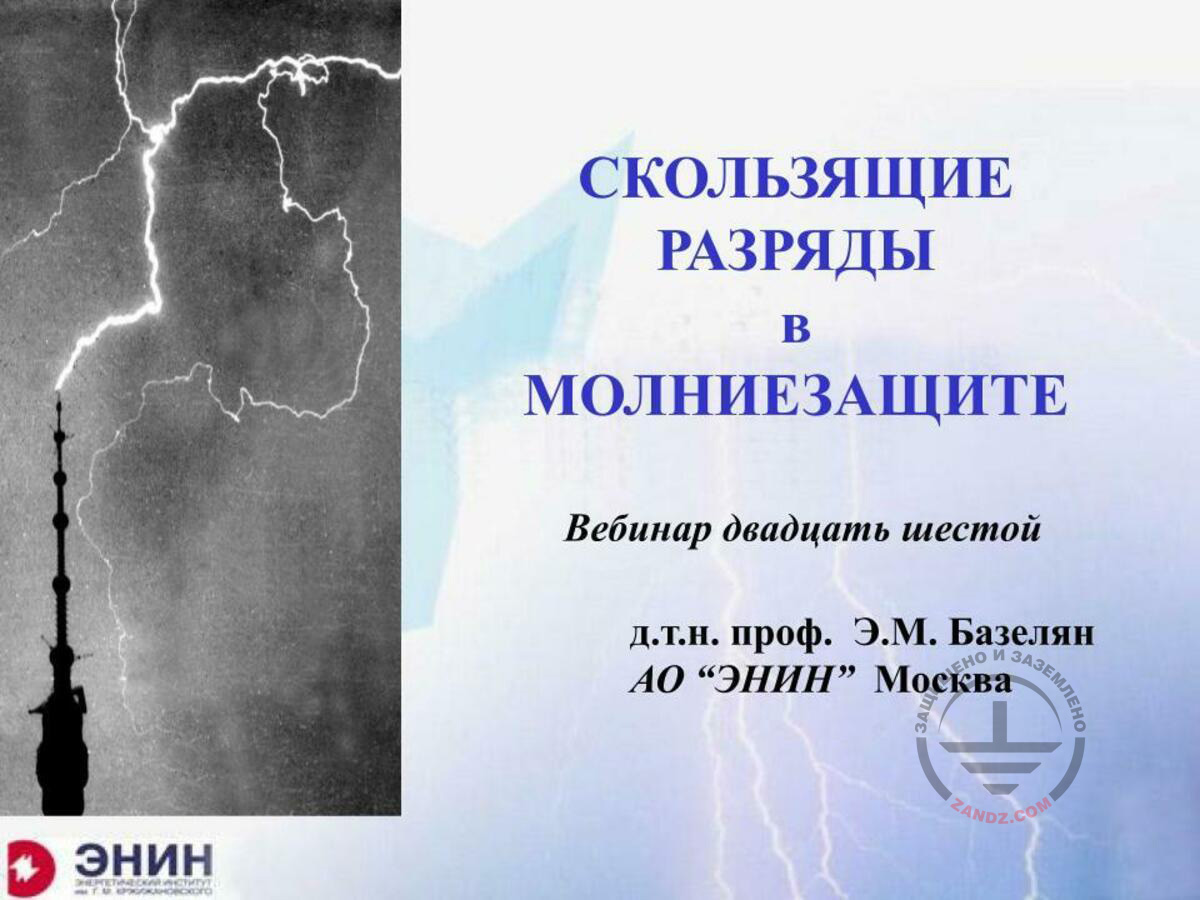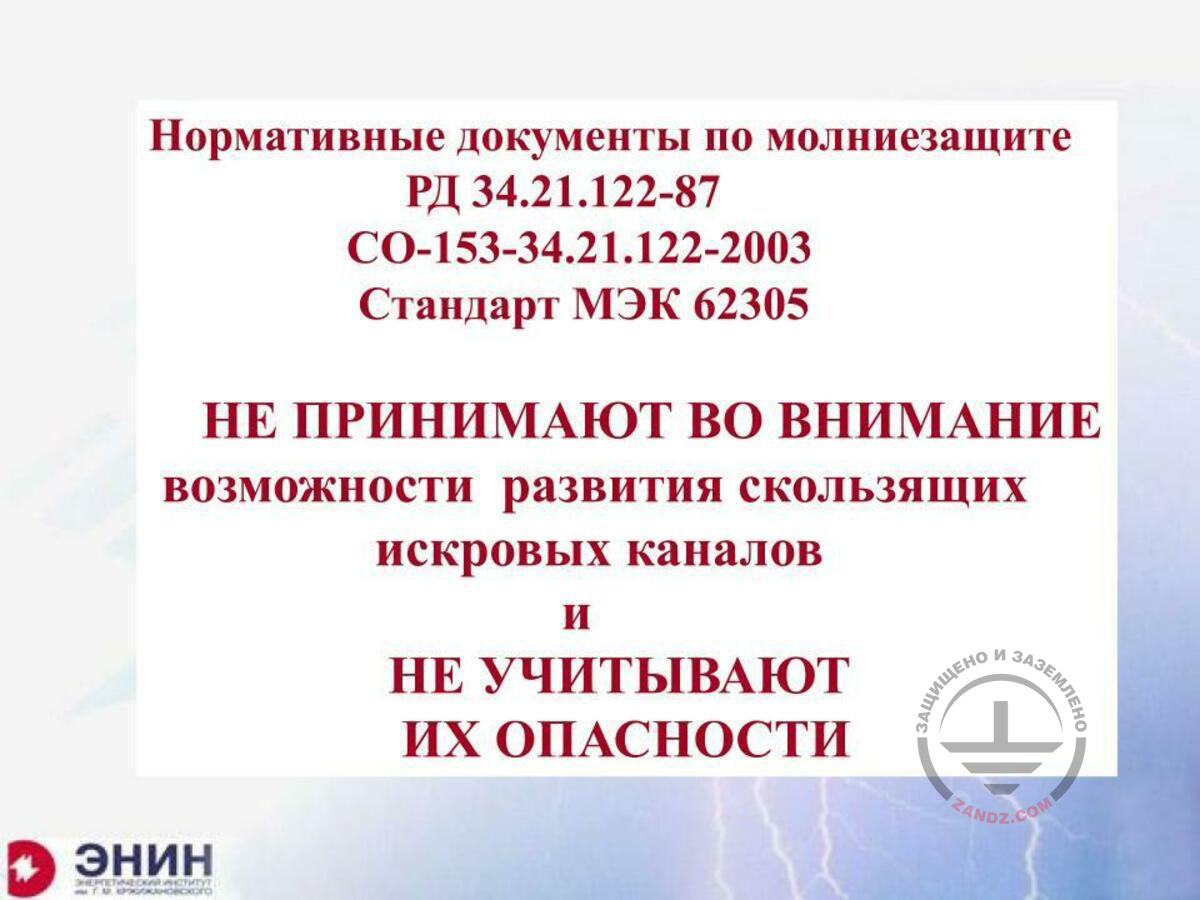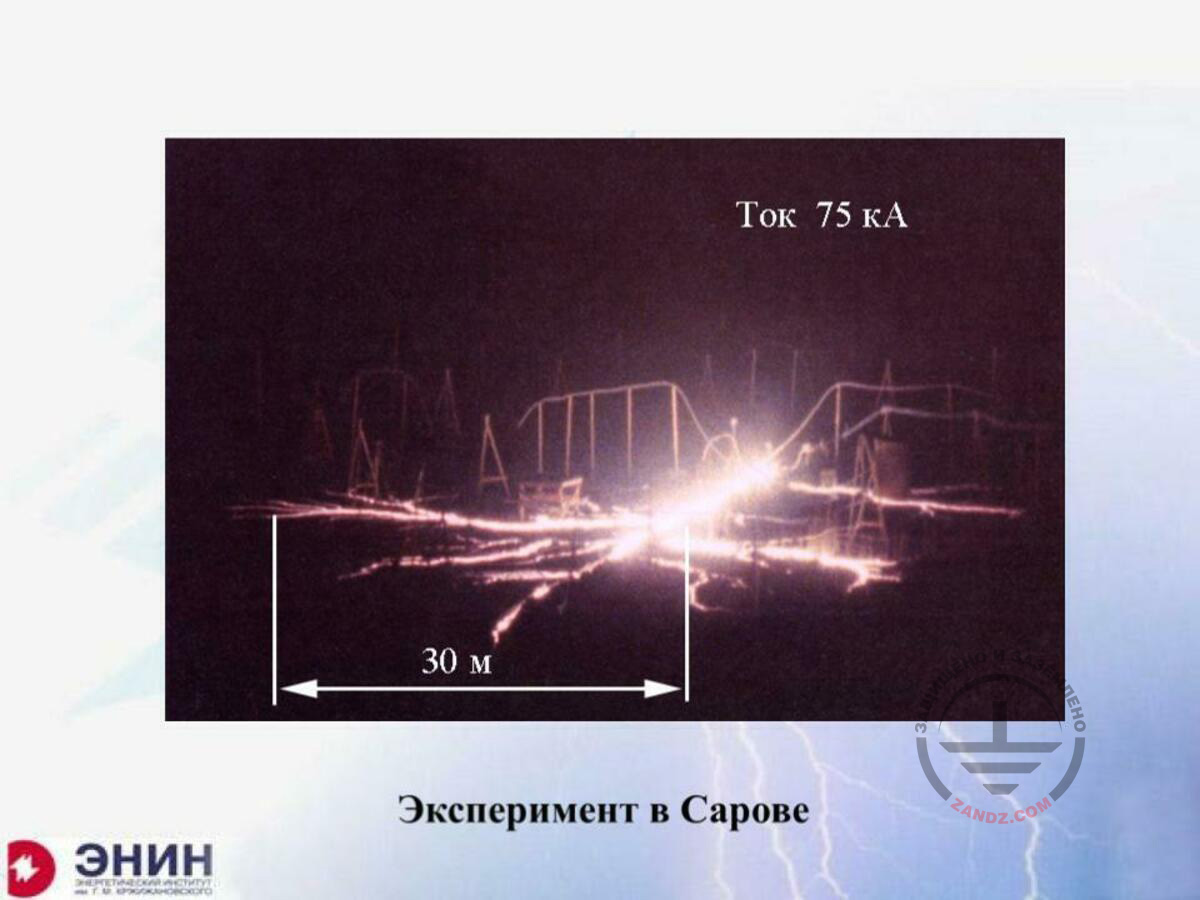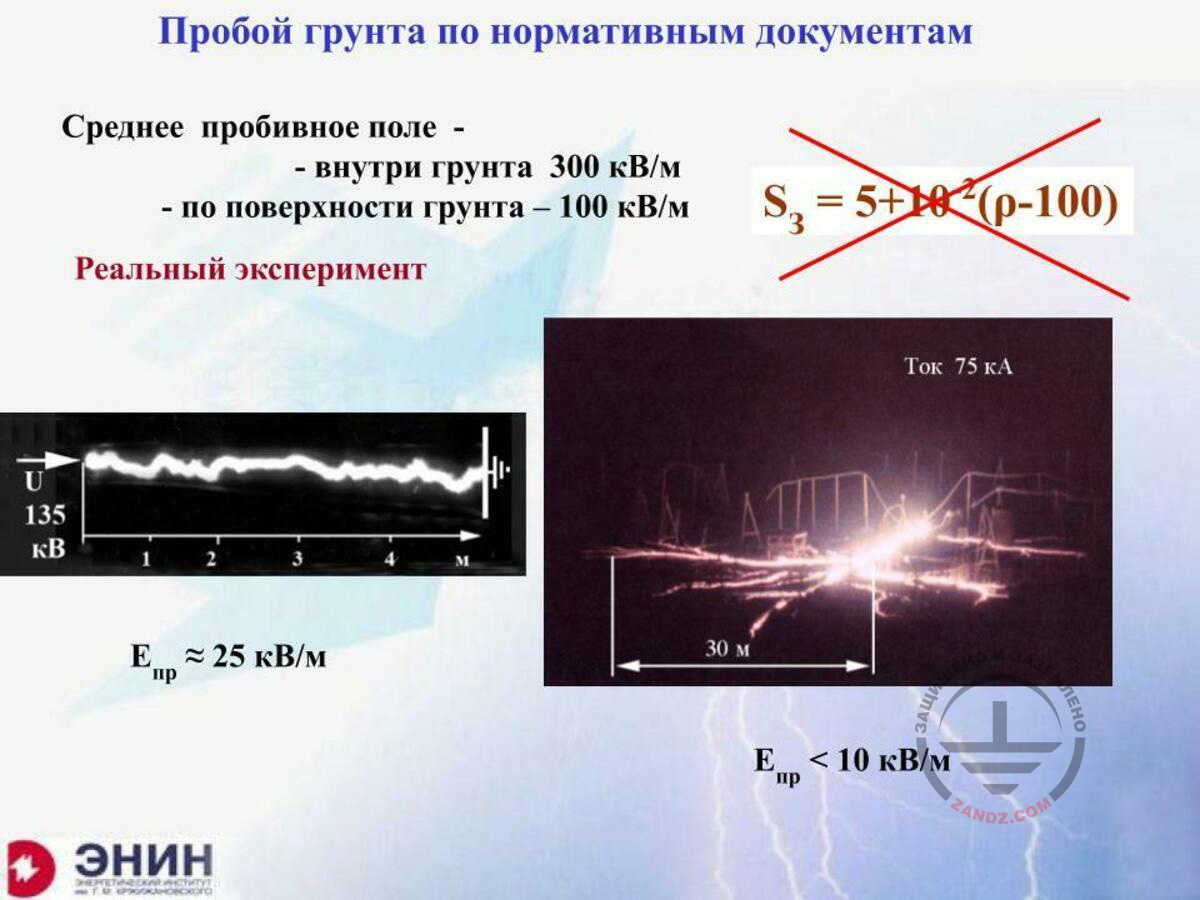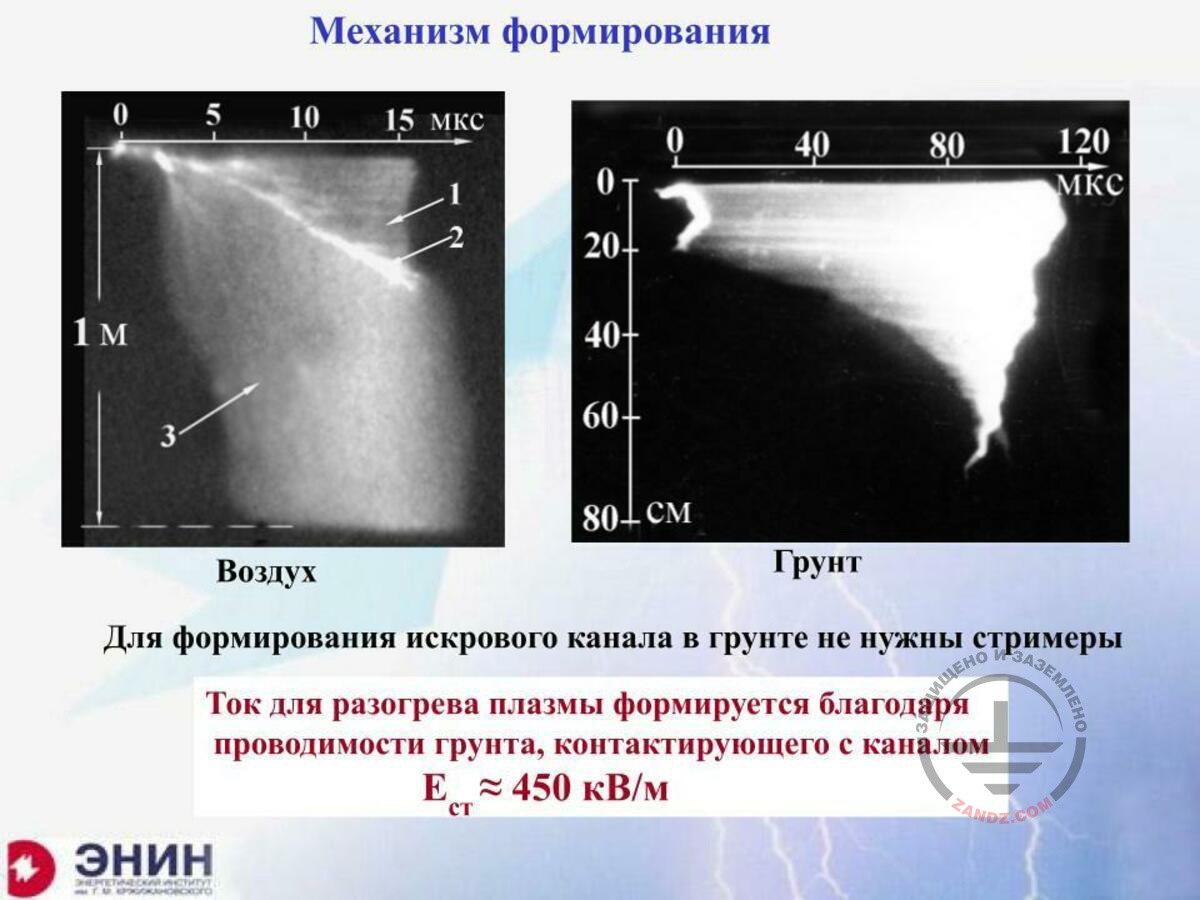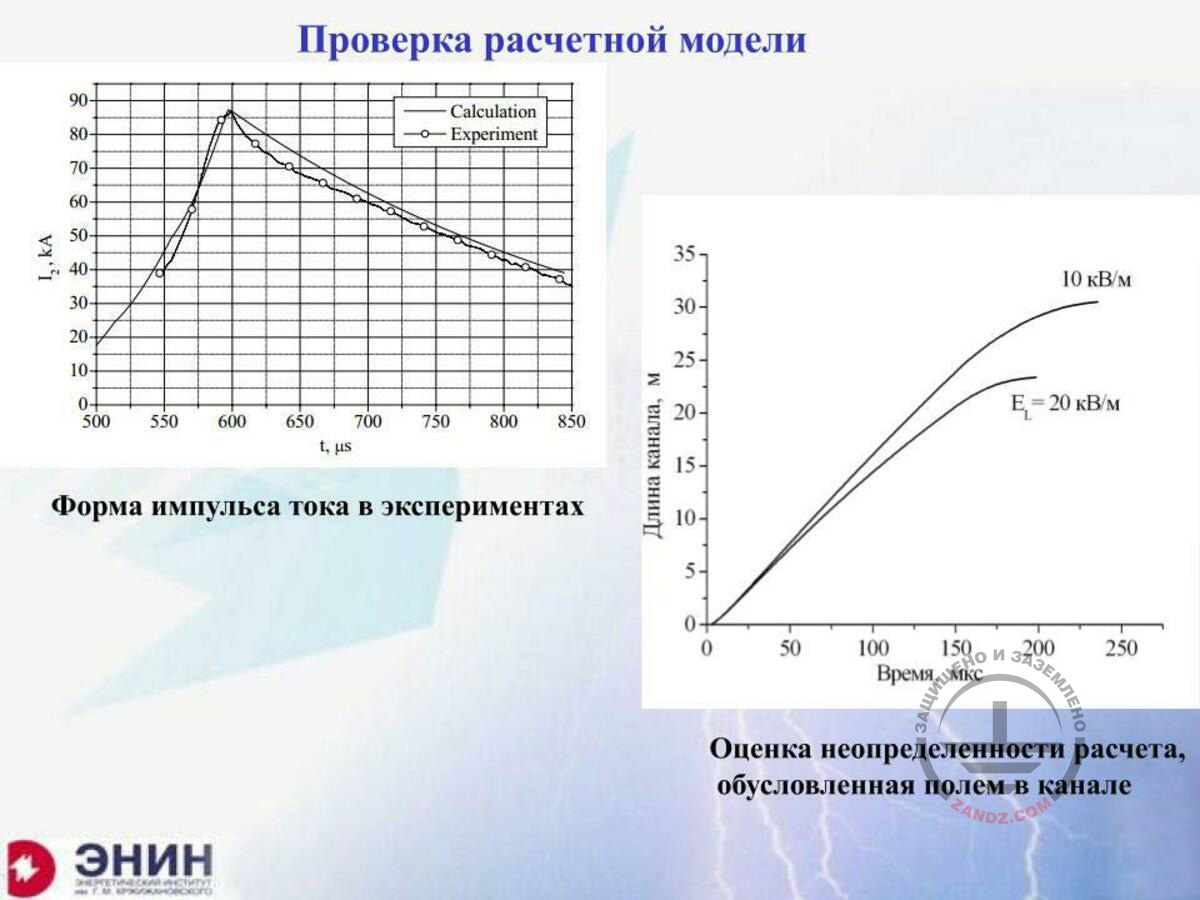(held on April 03, 2019 at 11:00)
The webinar is intended for: designers of lightning protection and earthing
Venue: online (you will need the Internet access on your PC)
Fee: free of charge
Duration: 60 to 90 minutes
1080p full screen watching is recommended.
Webinar text. Page 1
Fast navigation by slides:
Page 1:
1. Creeping discharges in the lightning protection
2. Regulatory documents for the lightning protection
3. Sarov experiment
4. Soil breakthrough according to the regulatory documents
5. Formation mechanism
6. Formation mechanism (continued)
7. Computer calculation method
8. Calculation model verification
Approximate reading time: 53 minutes.
Creeping discharges in lightning protection
СКОЛЬЗЯЩИЕ РАЗРЯДЫ В МОЛНИЕЗАЩИТЕ - CREEPING DISCHARGES IN LIGHTNING PROTECTION
Вебинар двадцать шестой - The twenty-sixth webinar
Д.т.н. проф. Э.М. Базелян - Dr. Sc. (Eng.) Prof. E.M. Bazelyan
АО «ЭНИН» Москва - AO “ENIN”, Moscow
– More than 60 years ago, I came to the department of the high voltage equipment to work. Accidentally, I met a person, Elena Ryabkova, who was engaged in studying high pulse currents flowing in the ground. And this person who is no longer alive played an essential and important role in my life because she got me interested in the issues related to the lightning current flowing; on the one side, she taught me to perform research, and, on the other side, she taught me to be a simply educated person. I mean, to wash timely, to wear clean clothes, to cut nails, to give place to girls, i.e. to do anything that a boy from the small town in the Moscow Region could not do. And then I had many meetings with other outstanding experts in the area, and I have learnt much from them, but the significance of my first teacher, Elena Ryabkova, was the first. And therefore, probably the most important. By the way, her book dedicated to earthing devices was published by Gosenergoizdat. It is still popular. And Elena Ryabkova was the person who told me about these creeping discharges. To tell you the truth, she did not tell me. She showed me a book published in 1951. It was a theoretical research on the earth impact on the power line characteristics. And there was a last chapter among those theoretical researches that described this phenomenon: the discharges are creeping along the earth's surface from the lightning strike point, and the long grooves are left by these discharges, which are similar to the grooves left by a plow. And based on the grooves, you can trace the path of these discharges and the point of the lightning strike, and how the current has slipped through this distance of several meters bypassing the lightning arresters and struck that facility not in a traditional path, from the top, but rather from the bottom, by sliding along the earth surface while bypassing all lightning arresters. I read the book and got interested in these discharges. And now, I can show you the discharge that was sliding not on the ground surface but along the water surface. The mechanism of both phenomena is identical. And when we performed the initial research of these discharges, we made also them slide on water. I should say that the video we have downloaded from the Internet, was very impressive because the lightning was very powerful and caused much noise. Can you show this slide? Look carefully (the lightning strikes the river). First, it passed over the earth and then reached the water. This is the event and this is the way it looks like. Surely, such a powerful discharge is not accumulated from each lightning strike, such noises and cracks, but this process may cause pretty much trouble. What is the point? You have lightning arresters. The lightning arresters catch the lightning strikes. Imagine that you have calculated the lightning arrester well and it works with a very high reliability. And despite this very high reliability, the following events may occur. And the lightning strikes the lightning arrester, goes to the earthing device of the lightning arrester, and then from this earthing device, such a creeping and spark channel is developed and moves to a wrong direction. As a result of this, along the highly conductive channel, the current may go to the protected area, bypassing the lightning arrester.
Regulatory documents for lightning protection
Нормативные документы по молниезащите - Regulatory documents for lightning protection
РД 34.21.122-87 - RD 34.21.122-87
СО-153-34.21.122-2003 - SO-153-34.21.122-2003
Стандарт МЭК 62305 - Standard IEC 62305
НЕ ПРИНИМАЮТ ВО ВНИМАНИЕ возможности развития скользящих искровых каналов и НЕ УЧИТЫВАЮТ ИХ ОПАСНОСТИ - DO NOT TAKE INTO ACCOUNT the possibility of the creeping spark channel development and DO NOT CONSIDER ITS DANGER
The most important point is that today, not a single regulatory document, i.e. neither RD 34, nor SO-143, nor any IEC standard, takes into account this well-known fact. And if they do not take it into account, nobody takes the measures to protect against these discharges that may present a really serious danger.
Experiment in Sarov
Эксперимент в Сарове - Experiment in Sarov
30 м - 30 m
Ток 75 кА - Current 75 kA
This is how it looks like in real life. The photo you can see on the display was made in the Institute of the Experimental Physics in Sarov, which is located near Nizhny Novgorod. This is a very good research institute. And the photo you can see now was obtained when the explosion current of the magnetic generator of 75 kA was supplied to a typical lightning rod in the soil having the resistivity of a little bit higher than 200 Ohm*m. This is a pretty high current; about 80% of actual lightnings have a smaller current. And the result you can see is like this: there were about 8 long channels, and the longest channel is 30 meters. Now, imagine the following situation. Imagine that it happens, e.g., in the tank farm, where the liquid fuel is stored.
Soil breakthrough according to the regulatory documents
Пробой грунта по нормативным документам - Soil breakthrough according to the regulatory documents
Среднее пробивное поле- - Average breakthrough field-
- внутри грунта - 300 кВ/м - inside the soil — 300 kV/m
- по поверхности грунта - 100 кВ/м - on the soil surface — 100 kV/m
135 кВ - 135 kV
Ток 75 кА - Current 75 kA
Епр ≈ 25 кВ/м - Ebr ≈ 25 kV/m
Епр < 10 кВ/м - Ebr < 10 kV/m
This is a reality, and this reality may be generally modelled in the laboratory, when we studied the physics of these processes. This is what we did. What were we primarily interested in? We were interested in the way how to choose the isolation gap, at which these creeping discharges do not get to any dangerous object? The first question that has immediately appeared: a well-known electrical air strength, but probably there is also the electrical strength of the soil? Is it? Yes, you can read books. You can open the regulatory documents and see that this value exists. For example, it exists as follows: to break through one meter in the soil, we need the voltage of 300 kV. The regulatory document that has been translated on the basis of the IEC standards states this. Another document states that if the discharge does not go to the soil, and this discharge goes along the soil surface, this electrical strength value falls by about three times. It means that we need 100 kV to break one meter through. And now, we begin comparing these values with the results of the experiment. This photo was made in the pool containing the soil, during a combined work of our institute and the military and engineering construction institute. The length of such spark was 5 meters, and the voltage at which it developed is 135 kV. And it looks like for one meter, we needed a little bit more than 25 kV per one meter; 25 kV rather than 300 kV or even 100 kV. And now, let us get back again to the experiment performed in the Institute of the Experimental Physics in Sarov. This 30-meter channel was developed with the average electrical field strength of only 10 kV per one meter. What can we do with this now, especially if we consider that the EIC indicates this value? The isolation gap between the lightning arrester and the object should be chosen based on this formula, and it is easy to make sure that this value is a little bit more than 5 meters. How can we use this value? Treat it like complete lies. Unfortunately, I cannot say anything else.
Formation mechanism
Механизм формирования - Formation mechanism
- плотность тока утечки - leakage current density
МВ/м - MV/m
Если радиус электрода ~ 1 см, порог ионизации для тока 100 кА будет превышен при общей длине заземляющих электродов < 160 м в грунте с ρ = 100 Ом м - If the electrode radius ~ 1 cm, the ionization threshold for current 100 kA will be exceeded with the total length of earthing electrodes < 160 m in the soil having ρ = 100 Ohm m
Ионизация возможна для любых заземлителей за исключением контуров заземления большой площади! - Ionization is possible for any earthing devices except for the earthing circuits of large area!
Зона ионизации - Ionization zone
Искровой канал - Spark channel
And in order to understand what it means, we have to do the things that the designers do not really like to do. We have to study then: why does it happen? That the channel that is formed in the air. I ask you to note that, in the air, when it slides along the earth surface, has the electrical strength of about 10 kV per one meter, while in the air without the soil, we will need about 500 kV per one meter for this. Do you understand it? We have to discuss it seriously. Let us start with the simple things. I like to ask the following question: is the soil a conductor? Certainly, people answer that it surely is! If it was not, then it would not provide earthing. And the second question is somewhat confusing. By how many times the earth resistivity exceeds that of the metal conductor, e.g., made of black steel? Different values are offered here, and different people have different imagination, but nobody mentions a correct value. The earth resistivity, even though it may be very good, by about one billion times higher than the resistivity of a metal, e.g., black steel. What does it mean? And it means that if the current flows in the earth, then, according to the Ohm's law, an electrical field is formed there. And if the electrical field exceeds about one million volt per one meter of length, ionization starts in the soil. The earthing bus located in the soil when it conducts the current is covered by the ionization enclosure. Due to such ionization enclosure, the bus radius somewhat increases, and as a result, the earthing resistance reduces.
Formation mechanism (continued)
Механизм формирования - Formation mechanism
Воздух - Air
Грунт - Soil
Для формирования искрового канала в грунте не нужны стримеры - The streamers are not needed to form a spark channel in the soil
Ток для разогрева плазмы формируется благодаря проводимости грунта, контактирующего с каналом - Current for heating plasma is formed due to the conductivity of the soil in contact with the channel
Eст ≈ 450 кВ/м - Est ≈ 450 kV/m
And now, the following question is raised: why does this channel go along the soil surface with a very low voltage that is several dozens of times less than in the air? You have a continuous photo of the channel movement in the air. This is its head, it is glowing brightly. Here, the ionization occurs in a very limited volume. The radius of this head is about one centimeter in the air. And to provide a strong field here, we do not need a high voltage. Why do we need it here? And this high voltage is needed for the channel that is beyond the head to maintain its conductivity. But in the cold air, a formed electron exists for not more than one tenth of a microsecond. And if this channel did not heat, then nothing would have happened. An ionization wave would occur, and such a conductive channel would not form. To accumulate energy in the air, which would heat this channel, we need a large ionization zone in front of the head that consists of separate streamer elements. Streamers are cold. They pass the current for a very short time, but there are many of them and they heat this channel in total. But its heating takes a high price because, in order to grow a streamer having the length of one meter, as shown here, we need about 500 kV. This is where we take high electrical strength of the air. And now look. This photo (from the right) of the discharge along the soil surface. We cannot see a head here. We cannot also see this streamer zone here, but the channel is glowing very well as it is hot. Why is it hot? No streamers are needed for heating it. This plasma channel contacts the soil surface; and this is the current that flows into the soil and heats this channel. This is the lightning mechanism that was invented by the nature. As a result of this, the electrical strength we need to form such channels is very low. And we only need 10 kV instead of 400 kV/m or 450 kV/m. This is the situation and an unusual and completely fantastic phenomenon.
Computer calculation method
Методика компьютерного расчета - Computer calculation method
Скорость определяется током головки канала - Velocity is defined by the channel head current
[см/мкс], если - [cm/mcs], if
Длина канала - Channel length
Определение тока головки канала - Defining the channel head current
Now, when you understand the essence, we can talk about the following aspect. Should we begin a conversation about what length these channel can have? To understand what lengths they can have, we need to know how the channel growth velocity is associated with the current that flows through its head. The current that flows through the head is associated with the velocity in the empirical relation that was determined in the series of experiments we had performed together with the All-Union Polytechnical Institute. And if I know the velocity, I can calculate the length as an integral of the velocity over time. The task is to find the current flowing through the channel's head. This is a purely electrotechnical task. It can be easily solved. It is solved due to the fact that we have an absolutely complete similarity between the electrostaticl field and the direct current field. This solution has been implemented in the computer software. If the participants need it, we can publish this software entirely at the website where we are talking right now. It is not a problem. As a result of this, we can do the following things.
Calculation model verification
Проверка расчетной модели - Calculation model verification
Форма импульса тока в экспериментах - Shape of current pulse in experiments
Длина канала, м - Channel length, m
Время, мкс - Time, mcs
Оценка неопределенности расчета, обусловленная полем в канале - Calculation uncertainty evaluation caused by the field in the channel
кВ/м - kV/m
We have an opportunity to calculate and check the results of these calculations, compare with the experiment and make sure that we calculate it properly. When we performed such works, we took the current pulse that is shown here, in the oscillogram, and that was recorded during the experiments conducted in the Institute of the Experimental Physics in Sarov we were talking about. We have taken this current pulse, we have taken the software and begun calculations. It is because we knew the number of channels from the photo we had. The only uncertainty was the electrical field along the channel's length. But it appeared that this electrical field along the channel does not affect the calculation results much. Finally, the calculation results aligned well with the experiments, and we made sure that we can calculate well. Look at how the channel length varies over time. The difference is very minor with the field strength of 10 kV and 20 kV/m.
Next page >>
slides from 9 to 16
Related Articles:
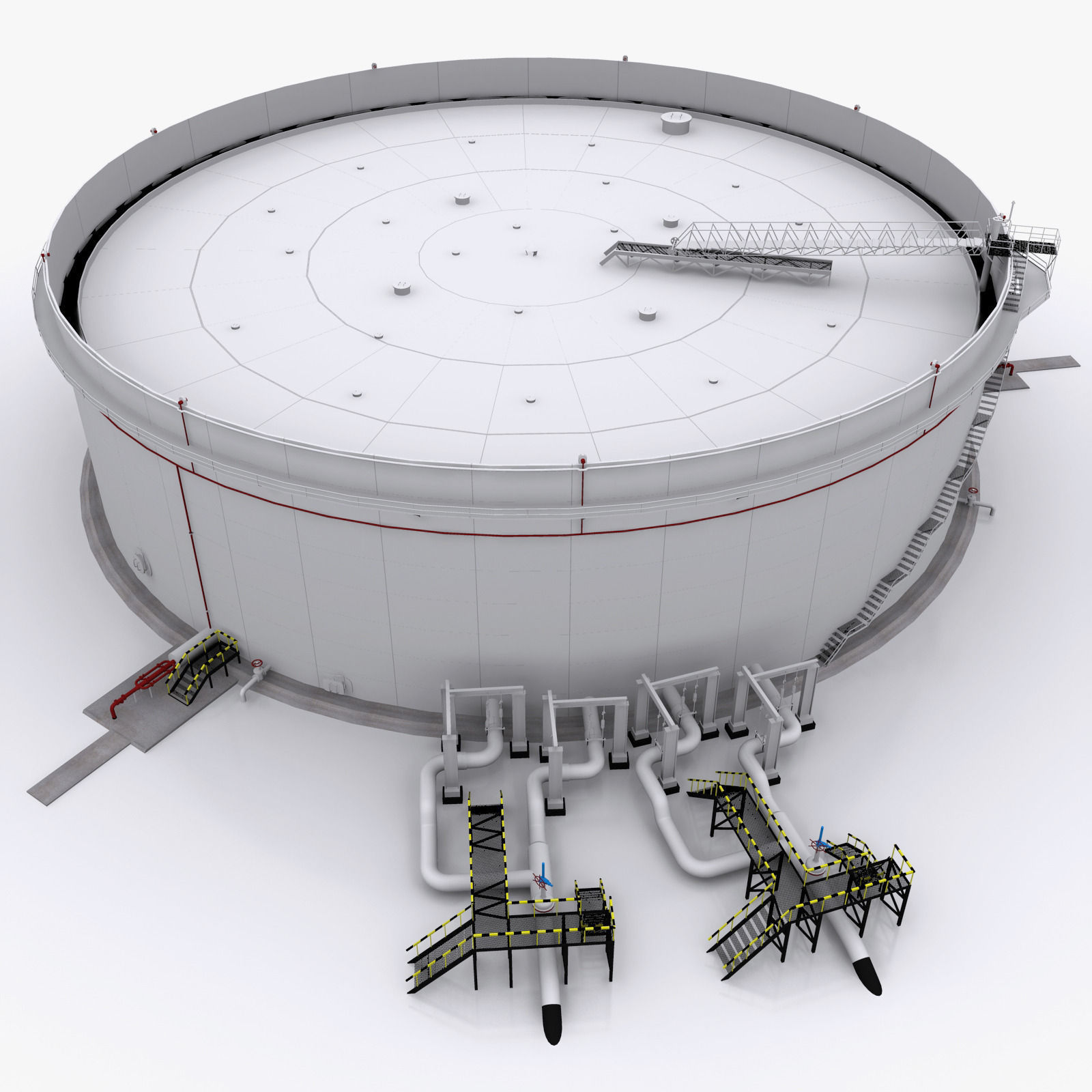 Protection of Fuel and Lubricant Materials (FLM) Storages with Floating Roofs Against the Static Electricity
Protection of Fuel and Lubricant Materials (FLM) Storages with Floating Roofs Against the Static Electricity
 2019 ZANDZ Competition for the Best Earthing System and Lightning Protection
2019 ZANDZ Competition for the Best Earthing System and Lightning Protection

 Lightning Protection of Large Territories: Parks, Grounds, Plant Territories. Page 1
Lightning Protection of Large Territories: Parks, Grounds, Plant Territories. Page 1
 Lightning Protection of Large Territories: Parks, Grounds, Plant Territories. Page 2
Lightning Protection of Large Territories: Parks, Grounds, Plant Territories. Page 2
 Lightning Protection of Large Territories: Parks, Grounds, Plant Territories. Page 3
Lightning Protection of Large Territories: Parks, Grounds, Plant Territories. Page 3


